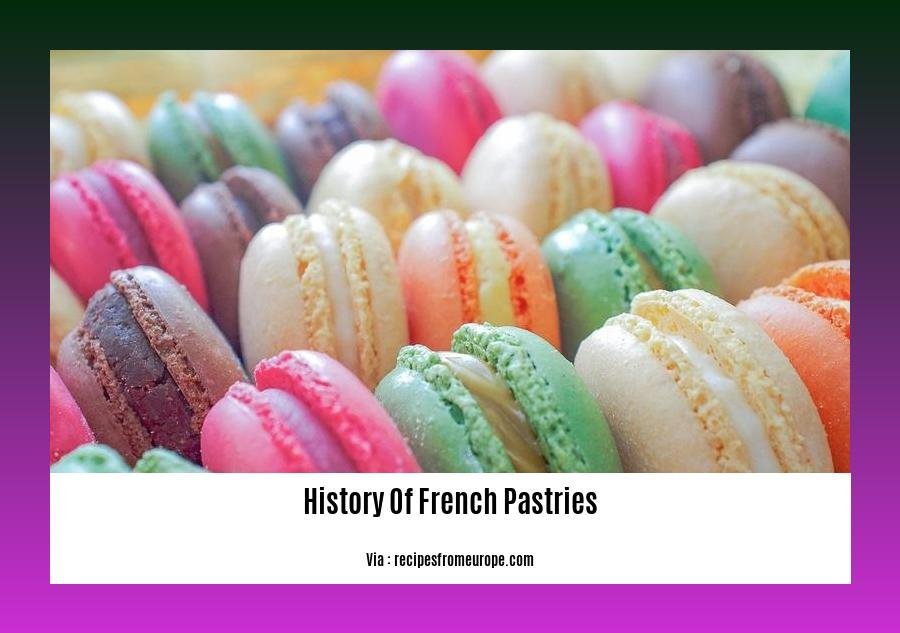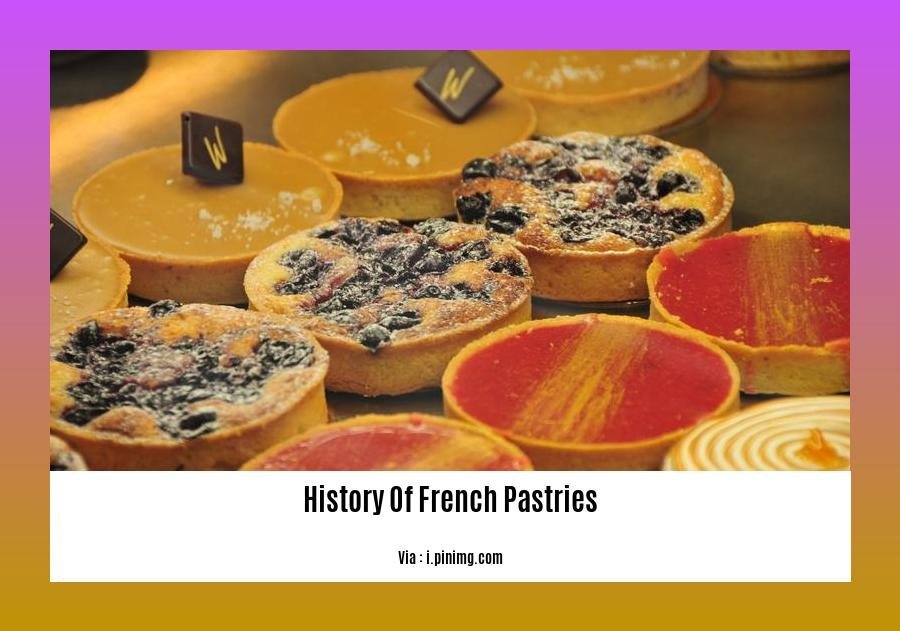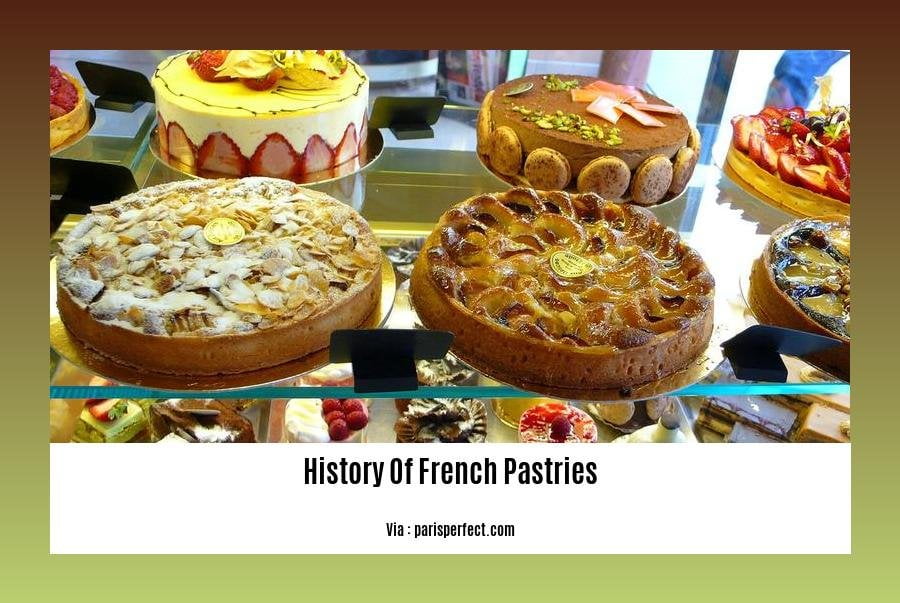Embark on a delectable journey through the rich history of French pastries in [Unveiling the Sweet History of French Pastries: A Culinary Journey Through Time]. Explore the origins and evolution of these culinary masterpieces, from the opulence of the royal courts to the humble beginnings of the Parisian patisserie. Discover the stories behind iconic pastries like the croissant, éclair, and macaron, and the talented pastry chefs who shaped their legacy. Prepare to be enchanted as we delve into the fascinating world of French pastries, where history, artistry, and indulgence converge.
Key Takeaways:
The history of French pastries dates back to the Middle Ages, when a distinct separation between cooks and pastry cooks was established.
The 17th century saw the introduction of chocolate to France by Anne of Austria, inspiring new and creative pastries.
Catherine de Médicis and Henri II’s wedding showcased the first ice creams alongside pâte à choux, a light pastry dough invented by Popelini.
French pastries are renowned for their exquisite designs, delicate flavors, and commitment to high-quality ingredients.
Croissants, éclairs, macarons, mille-feuilles, and Paris-Brest are among the most beloved and iconic French pastries.
French pastries have garnered global recognition and have become treasured delicacies enjoyed by people worldwide.
History of French Pastries

Have you ever savored a croissant’s flaky layers, marveled at the delicate elegance of an éclair, or succumbed to the allure of a macaron’s vibrant colors? If so, you’ve tasted a piece of French pastry history.
A Rich Tapestry of Flavors and Craftsmanship
The history of French pastries is an epicurean journey that spans centuries, intertwining with the country’s rich cultural heritage. Let’s delve into the fascinating evolution of these culinary delights:
1. Medieval Origins: Laying the Foundation
The roots of French pastries can be traced back to the Middle Ages, when a distinction between cooks and pastry cooks emerged. These skilled artisans, known as “pâtissiers,” specialized in creating intricate pastries that showcased their mastery of doughs, fillings, and glazes.
2. The Renaissance: A Flourishing of Flavors
During the Renaissance, French pastries experienced a renaissance of their own. The introduction of new ingredients, such as sugar and spices from the East, ignited a wave of innovation, giving rise to a dazzling array of pastries that tantalized the taste buds of royalty and commoners alike.
3. The 17th Century: A Culinary Revolution
The 17th century marked a pivotal moment in the history of French pastries with the arrival of Anne of Austria, who brought chocolate from Spain to France. This exotic ingredient sparked a culinary revolution, inspiring pastry chefs to create delectable new pastries infused with the rich, velvety flavor of chocolate.
4. The 18th Century: Refinement and Elegance
The 18th century witnessed a surge in the popularity of French pastries as they became a staple of the aristocratic lifestyle. Pastry chefs elevated their craft to an art form, creating exquisitely crafted pastries that showcased their technical prowess and artistic flair.
5. The 19th Century: A Golden Age of Pastry
The 19th century ushered in a golden age for French pastries. The invention of the ice cream maker led to the creation of ice cream-based pastries, such as the iconic éclair. Meanwhile, the development of new baking techniques and the rise of celebrity pastry chefs further propelled the popularity of French pastries around the world.
6. The 20th Century: Innovation and Globalization
The 20th century saw French pastries continue to evolve and spread their influence globally. Pastry chefs experimented with new flavors and techniques, pushing the boundaries of the art form. At the same time, French pastries became increasingly accessible, gracing the tables of homes and bakeries worldwide.
In our next segment, let’s embark on a delicious journey through some of the most iconic French pastries that have captured the hearts of pastry enthusiasts around the world.
Curious about the evolution of energy drinks? Delve into the history of energy drinks and discover how these beverages became a global phenomenon.
Unravel the rich tapestry of French patisserie in our comprehensive exploration of its history. From humble beginnings to its status as a culinary art form, this journey will delight your taste buds and transport you to the heart of French culture.
French pastries have played an important role in French cuisine and culture, and have been enjoyed by royalty, celebrities, and ordinary citizens alike.

From the Middle Ages to the present, French pastries have played a starring role in French gastronomy. They’re not just sweet treats, they symbolize the country’s rich history and culture. Picture this: a crisp croissant with its flaky layers, a delicate macaron with its vibrant colors, or an indulgent mille-feuille with its layers of pastry and creamy filling. These are just a few examples of the delightful creations that have emerged from French kitchens.
The history of French pastries is intertwined with the country’s culinary heritage. In the Middle Ages, skilled artisans known as “pâtissiers” specialized in creating intricate pastries for the nobility. During the Renaissance, new ingredients like sugar and spices were introduced, leading to a surge in innovation and creativity. By the 17th century, chocolate arrived from Spain, sparking a culinary revolution that transformed the world of pastries.
As the centuries passed, French pastries became increasingly popular among all walks of life. From the opulent banquets of kings and queens to the humble homes of ordinary citizens, these sweet treats were enjoyed by people from all backgrounds. In the 19th century, the invention of the ice cream maker and the rise of celebrity pastry chefs further elevated the status of French pastries, making them a global phenomenon.
Today, French pastries continue to captivate hearts and palates around the world. They’re a symbol of luxury, indulgence, and artistry. Whether you’re a royalty, a celebrity, or an everyday person, there’s a French pastry out there for you to savor and enjoy.
Key Takeaways:
- French pastries have a long and rich history, dating back to the Middle Ages.
- Skilled artisans known as “pâtissiers” played a crucial role in the development of French pastries.
- The introduction of new ingredients like sugar, spices, and chocolate transformed the world of French pastries.
- French pastries became popular among all walks of life, from royalty to ordinary citizens.
- In the 19th century, the invention of the ice cream maker and the rise of celebrity pastry chefs further elevated the status of French pastries.
- Today, French pastries are enjoyed worldwide and are considered a symbol of luxury, indulgence, and artistry.
Relevant Sources:
[1] The History Of French Pastry And Confectionery – Eat the Globe:
[2] French Pastry Culture 101 – Talk in French:
French Pastries: Adapting to Changing Tastes Through the Ages
French pastries have undergone numerous changes and innovations over the centuries, adapting to evolving tastes and preferences. The evolution of French pastries is a testament to the ingenuity and adaptability of pastry chefs who have consistently pushed the boundaries of culinary creativity.
Origins of French Pastries
Pastries have been a staple of French cuisine since the Middle Ages, with the first pastries appearing in the 13th century. These early pastries were simple in design and often filled with fruit or cheese. As sugar became more widely available in the 16th century, pastries became sweeter and more elaborate.
The Rise of the Pastry Chef
In the 17th century, pastry chefs emerged as specialized artisans, creating intricate pastries for the royal court and wealthy Parisians. This period saw the development of many classic French pastries, including the croissant, the éclairs, and the mille-feuille.
The Influence of the French Revolution
The French Revolution had a profound impact on French pastries. Aristocrats who had been the primary consumers of pastries were overthrown, and pastry chefs were forced to find new ways to make a living. This led to the development of smaller, less expensive pastries that could be sold to the general public.
The Industrial Revolution and Beyond
The Industrial Revolution brought new technologies that made it possible to mass-produce pastries. This led to the decline of small, artisanal pastry shops and the rise of large-scale bakeries. However, the quality of pastries remained high, as pastry chefs continued to experiment with new flavors and techniques.
Modern French Pastries
Today, French pastries are enjoyed all over the world. There are countless varieties of pastries available, from classic croissants to modern fusion creations. And while the techniques and ingredients used to make pastries have changed over the centuries, the passion and creativity of pastry chefs remain the same.
Key Takeaways:
- Timeline: The evolution of French pastries can be traced back to the Middle Ages, with significant developments in the 16th, 17th, 18th, 19th, and 20th centuries.
- Artisanal Origins: Early pastries were simple and often filled with fruit or cheese, created by skilled artisans known as “pâtissiers.”
- Sweet Revolution: The introduction of sugar in the 16th century transformed pastries, making them sweeter and more elaborate.
- Pastry Chefs as Artists: The 17th century saw the rise of pastry chefs as specialized artisans, creating intricate pastries for the royal court and wealthy Parisians.
- Democratic Desserts: The French Revolution led to the development of smaller, less expensive pastries that could be sold to the general public.
- Industrialization and Innovation: The Industrial Revolution brought mass production to pastries, but quality remained high as chefs continued to experiment.
- Global Delights: Today, French pastries are enjoyed worldwide, with countless varieties reflecting diverse tastes and influences.
Citations:
– The History of French Pastries and Confectionery
– French Pastry Culture 101
French Pastries: A testament to Culinary Excellence
French pastries continue to be popular around the world, and are regarded as a symbol of French culinary excellence. For centuries, these delectable creations have tantalized taste buds, leaving an unforgettable mark on the global culinary landscape.
The Birth of French Pastries
The history of French pastries is a tapestry woven with skill, artistry, and a touch of indulgence. It all began in the medieval era when monasteries and bakeries played a pivotal role in preserving and developing the art of baking.
Influences and Innovations
Over time, French pastries evolved, incorporating influences from around the world. The Renaissance ushered in new ingredients like sugar and spices, while the 17th century witnessed the arrival of chocolate, transforming the pastry landscape.
The Rise to Culinary Prominence
In the 18th century, French pastries ascended to new heights, becoming a staple of the aristocratic lifestyle. Intricate designs and luxurious ingredients elevated pastries to an art form, showcasing the skill and creativity of French pastry chefs.
French Pastries Today
Today, French pastries are celebrated globally, gracing patisseries, bakeries, and cafes worldwide. Their popularity stems from their unique flavors, textures, and the artistry involved in their creation.
Key Takeaways:
- French pastries have a rich history dating back to the Middle Ages.
- Monasteries and bakeries played a crucial role in preserving and developing the art of baking.
- French pastries evolved through influences from around the world, including the introduction of sugar, spices, and chocolate.
- In the 18th century, pastries became a staple of the aristocratic lifestyle, showcasing the skill and creativity of French pastry chefs.
- Today, French pastries are celebrated globally for their unique flavors, textures, and artistry.
Relevant URL Sources:
- A Culinary Journey Through the History of French Pastries
- The Sweet History of French Pastries
FAQ
Q1: What is the origin of French pastries?
A1: French pastries have a rich history dating back to the Middle Ages, when the distinction between cooks and pastry cooks was established. The first pastries were simple, made with flour, water, and salt, but they evolved over time to include more complex ingredients and techniques.
Q2: Which historical figures have influenced French pastries?
A2: Many notable figures have contributed to the evolution of French pastries. One of the most influential was Catherine de Médicis, who introduced ice cream to France in the 16th century. Marie-Antoinette, the wife of King Louis XVI, was also a great patron of pastry, and her favorite pastry, the brioche, remains popular today.
Q3: What are some of the most famous French pastries?
A3: Some of the most iconic French pastries include croissants, éclairs, macarons, mille-feuilles, and Paris-Brest. These pastries are known for their intricate designs, delicate flavors, and use of high-quality ingredients.
Q4: How have French pastries spread around the world?
A4: French pastries have spread all over the world through a combination of factors, including colonization, trade, and tourism. French chefs and bakers have traveled the world, sharing their skills and knowledge with others. French pastries have also been adopted by other cultures, who have adapted them to their own tastes and preferences.
Q5: Why are French pastries so popular?
A5: French pastries are popular for a number of reasons. Their intricate designs and delicate flavors are visually appealing and enticing. They are also made with high-quality ingredients, which gives them a rich and satisfying taste. French pastries are also often associated with luxury and sophistication, which makes them a popular treat for special occasions.
















